Having made the decision to have an adventure to Bolivia in search of two elderly Sulzer powered locomotives, the travel guides were consulted to research what attractions might be of interest to this wayward traveller. With a desire to sample some of the passenger trains a check of the possibilites showed that the Oruro - Villazon service was a strong contender. A look at the map of the route showed that the route passed through Uyuni, which received several references in the tourist guides. Of great interest was the 'cementerio de trenes', the train cemetery located south of the town at the junction where the lines to Chile and Argentina separate.
Since the Oruro - Villazon service was basically an out and back working which left the traveller with the possibility of a 24 hour stay at Uyuni, the decision was made to forego the Uyuni - Villazon route for another time. Another factor in the decision was that a considerable amount of the journey would have been at night. So on the southbound trip we arrived at Uyuni late in the evening, accomodation was obtained at the Hotel Avenida across the street from the station. The nightime arrival shielded the traveller from the reality of the location of Uyuni until the next morning.
But whatever the location the day dawned bright, cold and clear for the 11,000 or so residents of Uyuni and a small number of tourists. At an elevation of about 3,660 metres during the spring season the days start out very chilly and if the sun shines they can get a little toasty later in the day. The guide books describe the conditions as 'harto frio' or 'frigido', in other words cold or climactically challenged.
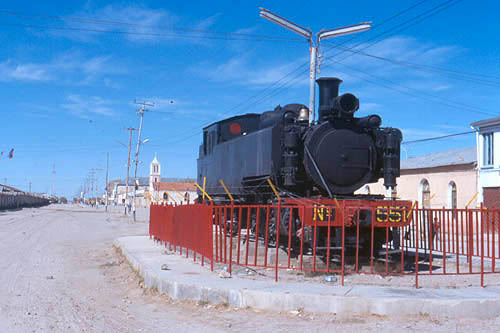
After a fine cooked breakfast around the corner at a cafe on Av Arce a walk was taken up Av Ferroviaria to investigate the plinthed steam locomotive in the middle of the street (see view above). This locomotive was one of a pair of 2-8-4T Hunslet's, works numbers 1102 & 1103 of 1912, built for the FCAB and numbered 101 & 102, later 411 & 412 and as 551 & 552 in the ENFE numbering. Although showing the number '551' this is infact 552. The 551 is one of sixteen locomotives parked at the back of Uyuni shed (as of April 2008). Photographs of this locomotive in service show it being equipped with an American style cowcatcher, a large boxy headlamp, only one airpump and an extension to its bunker to allow it to carry a greater quantity of fuel. The view above is looking south, the railway facilities including the station are on the left whilst much of Uyuni's central business district is off to the right.
After inspecting the plinthed Hunslet the walk was made down to the 'train cemetery'. This is not difficult to find, just follow the railway tracks south until you reach the junction of the the lines to Chile & Argentina. The guide books say its about one kilometer, I thinks its a little further than that. There are two distinct lines of abandoned steam locomotives as well as an area at the north end of the yard which is just a jumble of partially dismantled equipment.
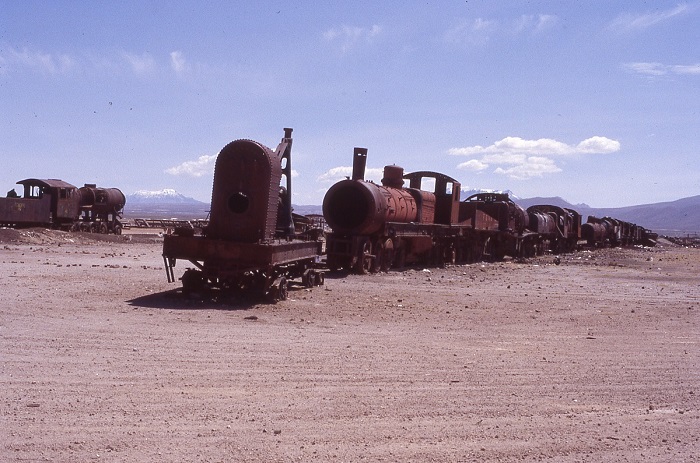
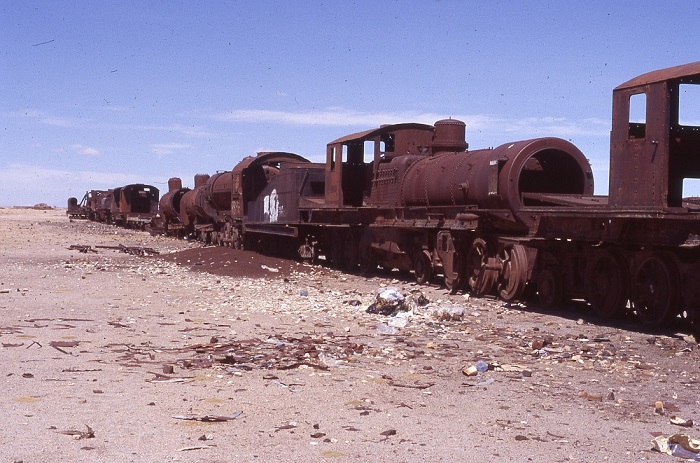
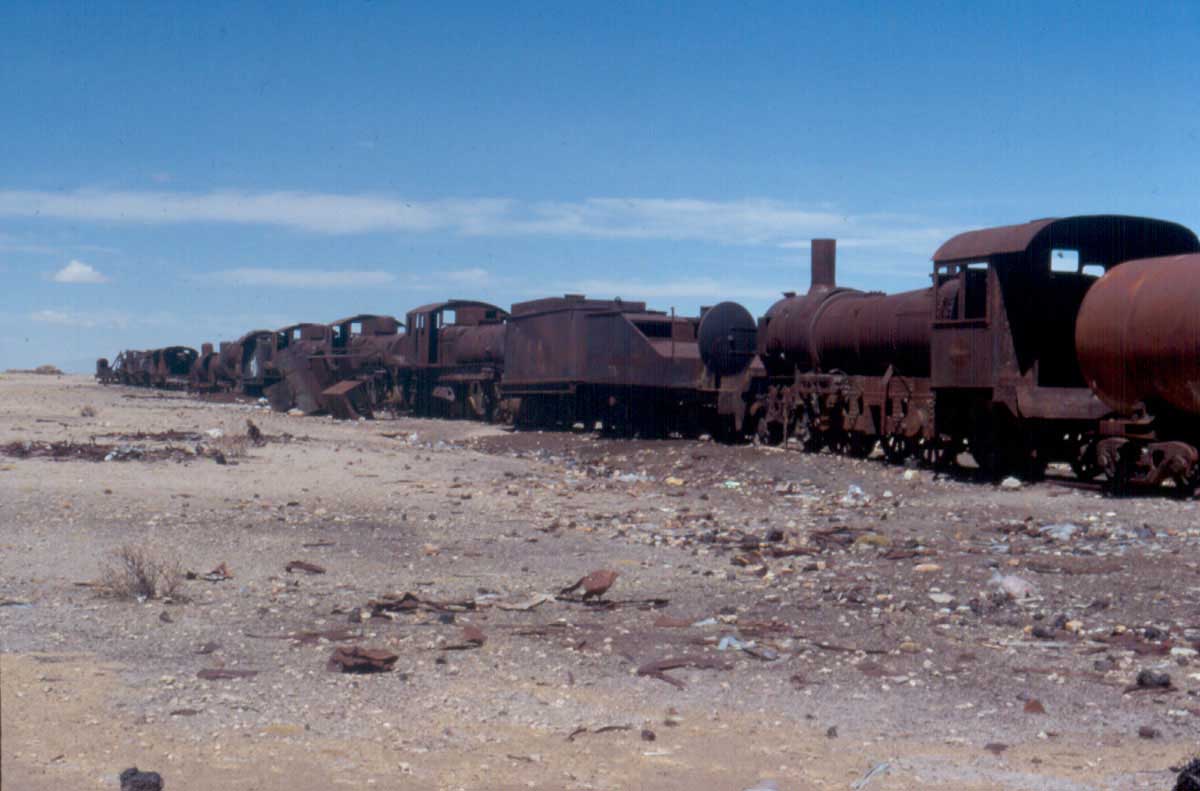
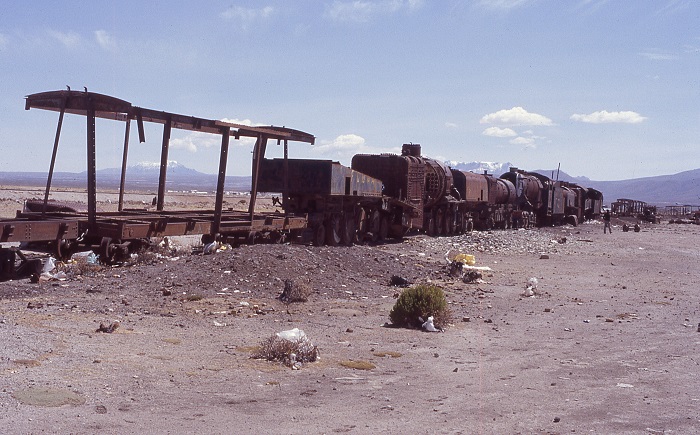

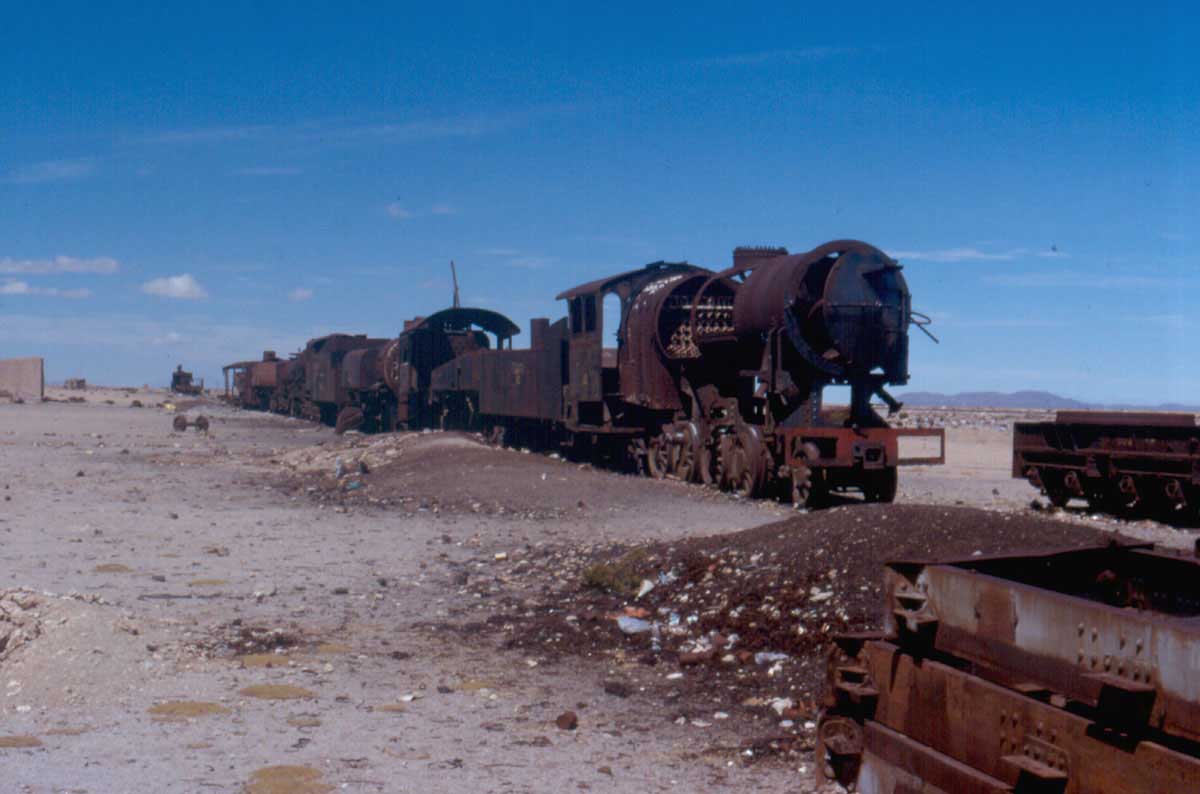
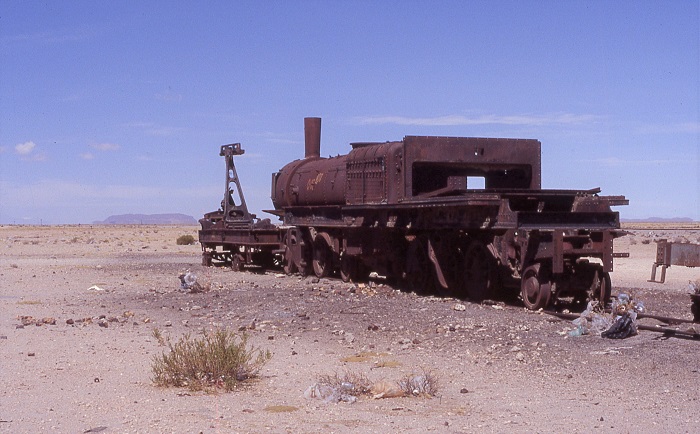
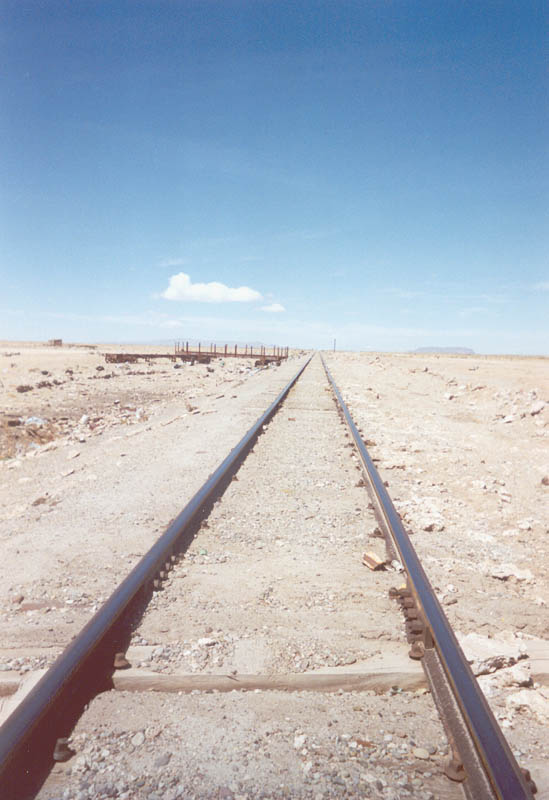
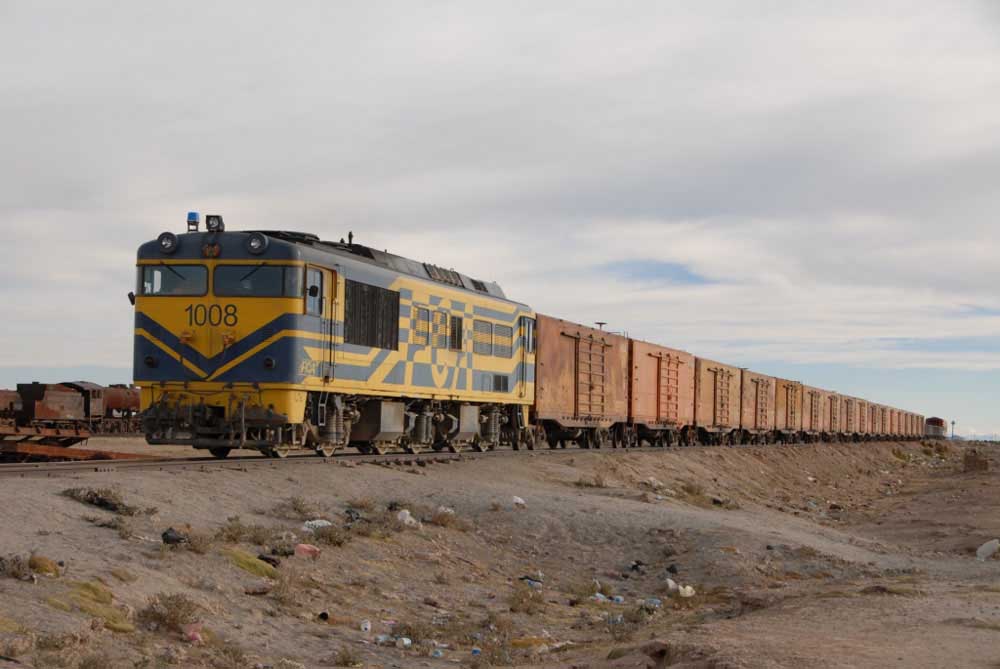
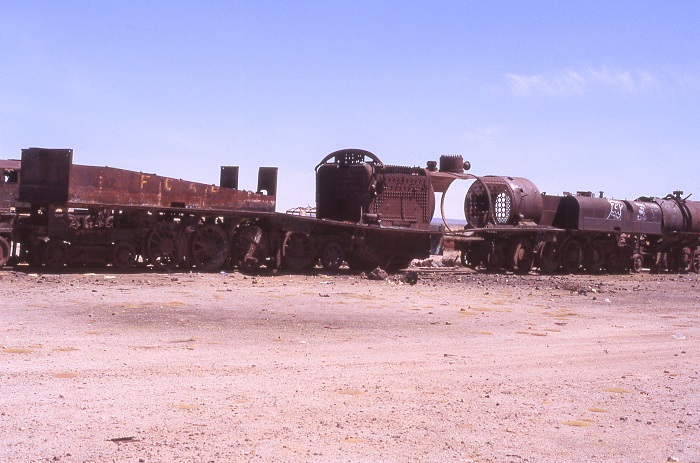

At the north end of the yard where the two distinct lines of steam locomotives ends the yard turns into a jumble of equipment. There is a mixture of dismantled steam locomotives parts, other rollings stock, both freight and passenger and other miscellaneous scrap items. Some of the rolling stock appears to be there because it sustained collision damage at some point whilst other equipment appears to be simply life expired.

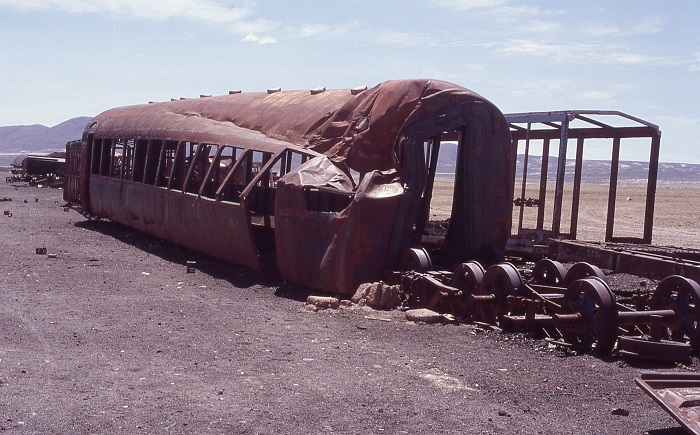
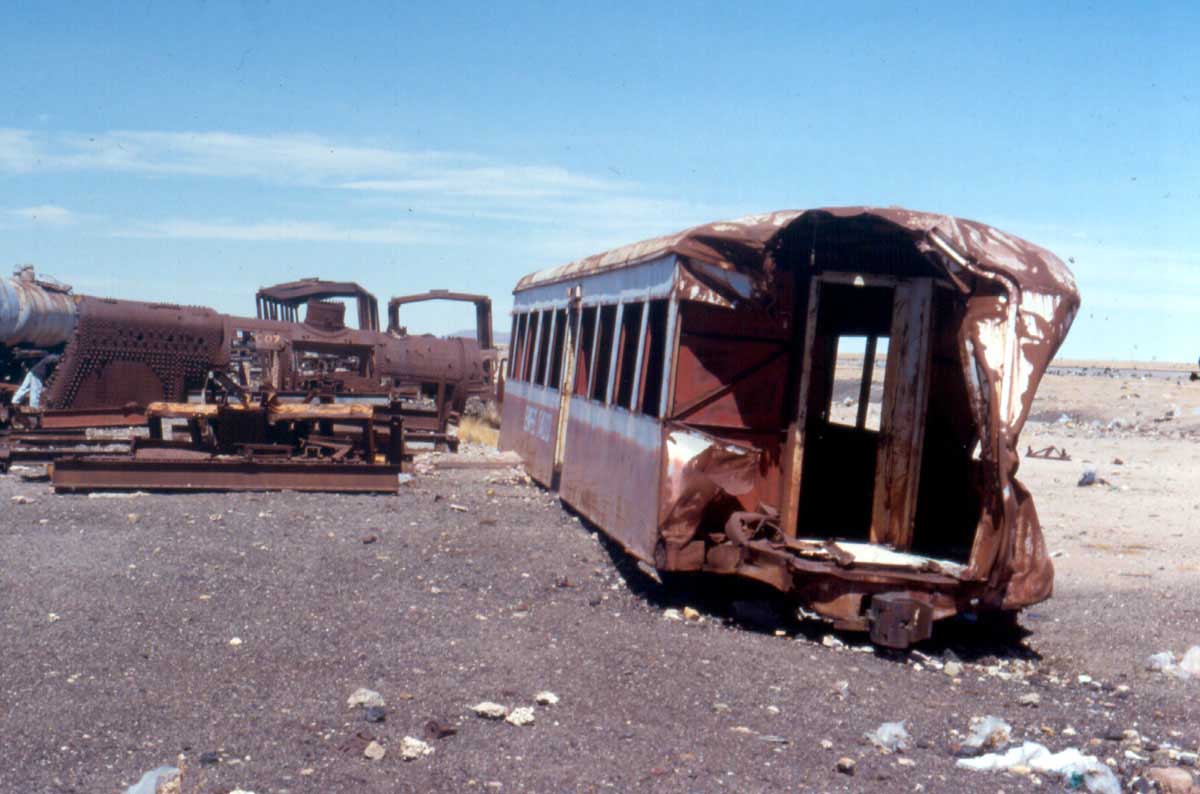
The above three views all feature some type of passenger carrying rolling stock. The coaches in the left and right views still carry quite a bit of original paint and lettering whilst the center view shows an all steel coach probably dating from about 1950. Although it appears to be almost devoid of paint it would have carried a green livery when new.
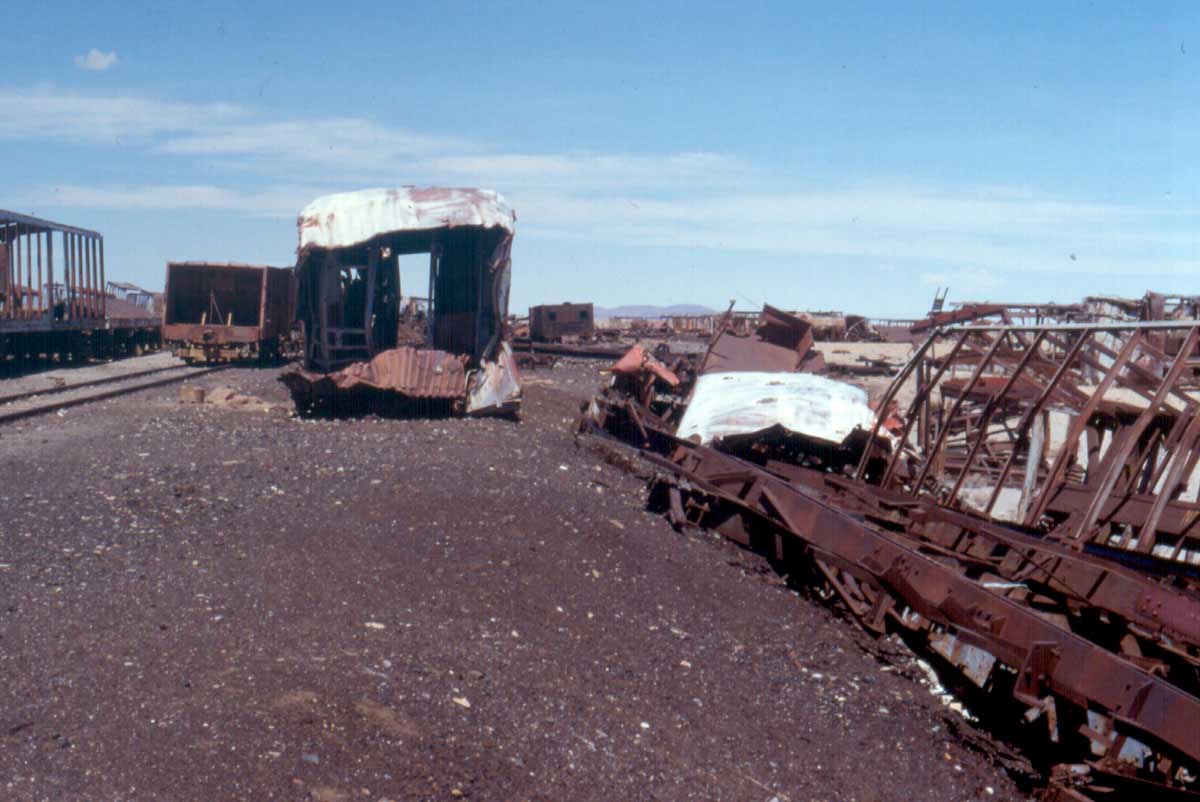
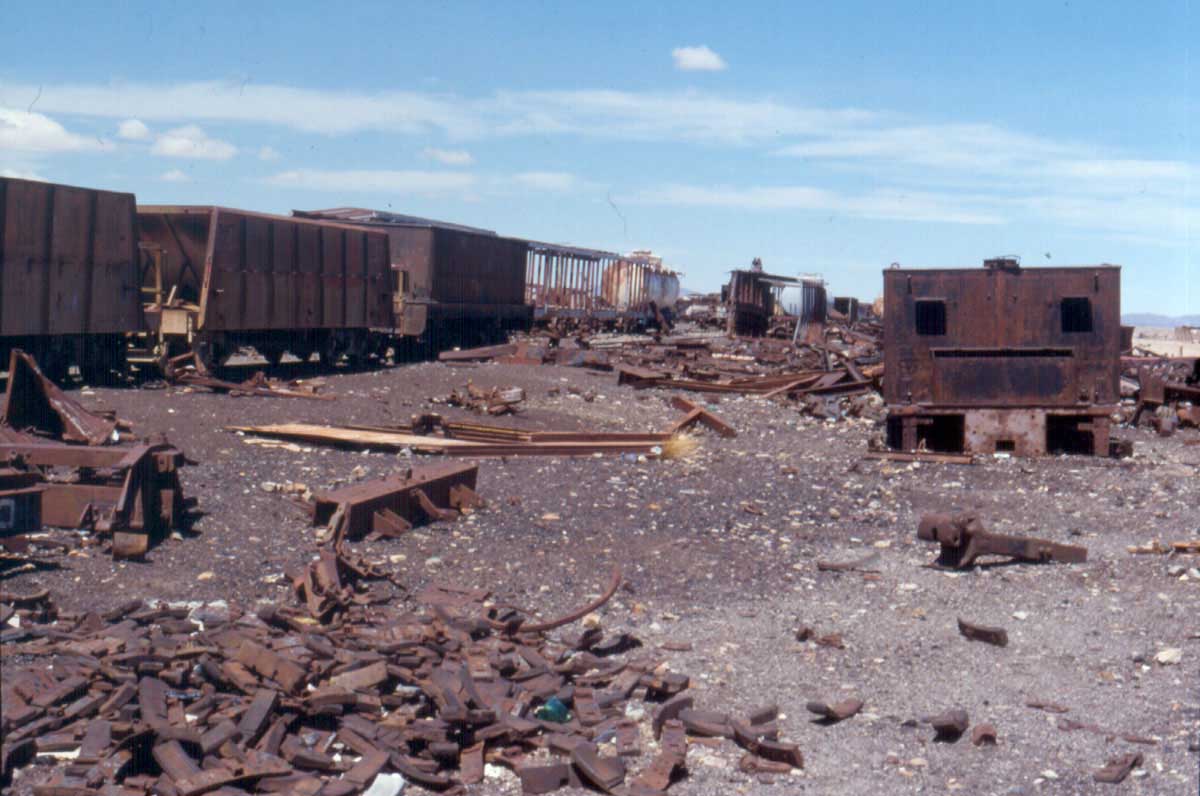
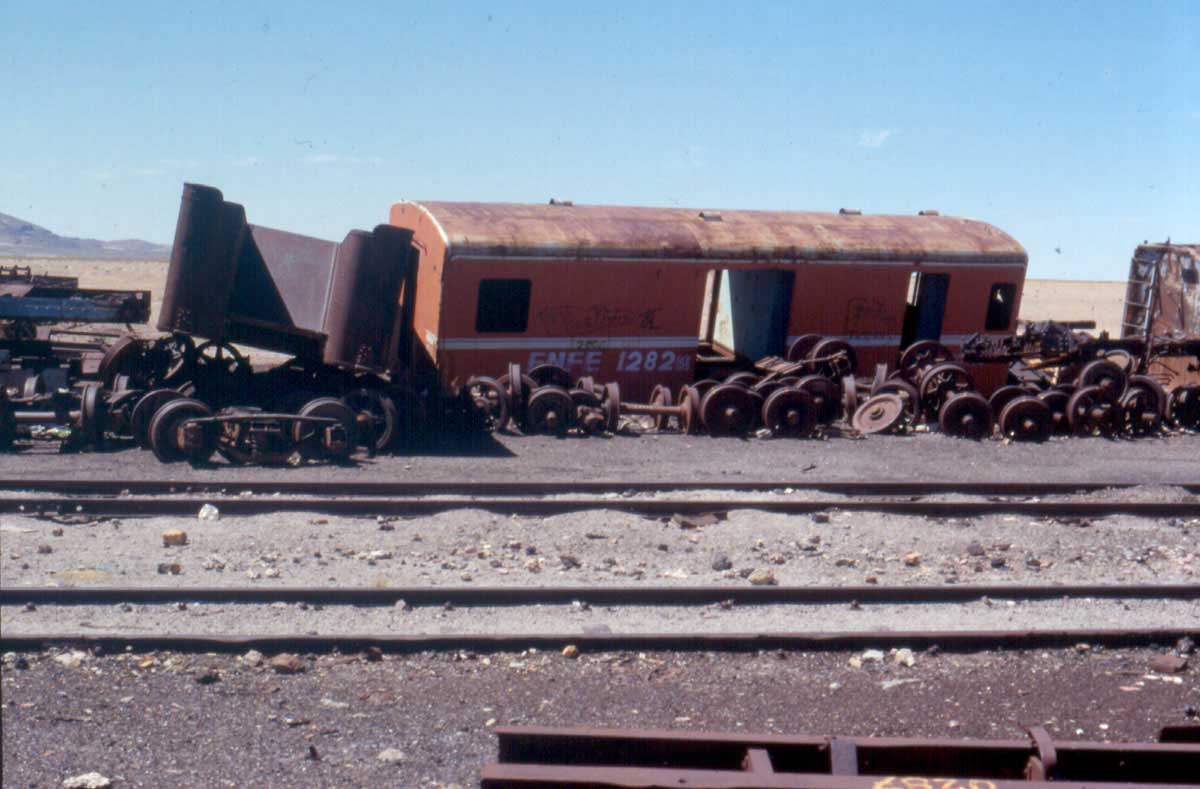
Three other views (above) feature other identifiable rolling stock. The left view shows freight cars to the left parked in somewhat of an orderly fashion whilst to the right of them is a jumbled collection of wagon and bodyside frames, all tossed about. The second view shows a jumble of scrap, including two tenders and several types of freight wagons. And the third view, looking in the direction of Argentina show what maybe a baggage coach, a varied selection of wheels, and the body of a tender turned end on to the photographer.
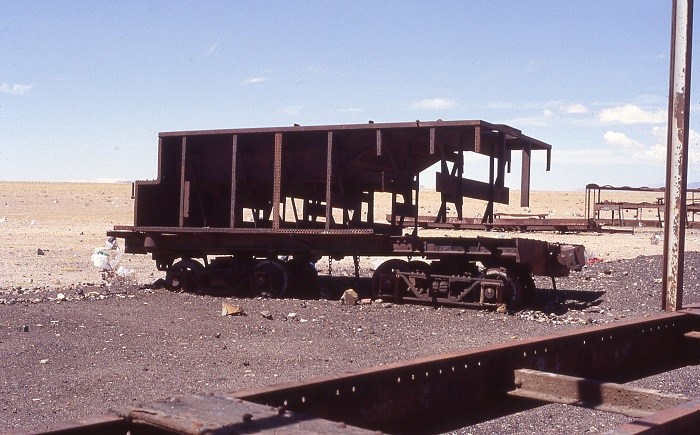
Identity of the locomotives at the train cemetery (as of April 2008):
| FCA No. | ENFE mark | Wheel Arrangement | Maker | Builders No. | Date | Remarks | FCAB 403 | L11-017 | 2-8-0 | Alco-Rogers | 41132 | 1906 | no tender | FCAB 404 | L12-018 | 2-8-0 | Alco-Rogers | 41133 | 1906 | no tender | FCAB 409 | L10-014 | 2-8-2 | K | 4860 | 1913 | no tender | FCAB 410 | L09-013 | 2-8-2 | K | 4861 | 1913 | no tender | FCAB 451 | L07-011 | 2-6-0+2-6-0T | Beyer Peacock | 5617 | 1913 | . | FCAB 452 | L15-021 | 2-6-0+2-6-0T | Beyer Peacock | 5618 | 1913 | . | FCAB 453 | 0392 | 2-6-0+2-6-0T | Beyer Peacock | 5619 | 1913 | Parts of frame only | FCAB 454 | L01-002 | 2-6-0+2-6-0T | Beyer Peacock | 5620 | 1913 | . | FCAB 455 | L14-020 | 2-6-0+2-6-0T | Beyer Peacock | 5621 | 1913 | . | FCAB 456 | L16-022 | 2-6-0+2-6-0T | Beyer Peacock | 5622 | 1913 | . | 660 (FCVA 4?) | L06-008 | 2-8-2 | Borsig | 11846 ? | 1925? | . | 703 (FCVA 6) | L04-006 | 2-10-2 | Borsig | 11956 | 1927 | . | 715 | L13-019 | 4-8-2 | Borsig | 14596 | 1935 | . | 756 (FCAB 333) | L17-025 | 4-6-2 | Henschel | 12748 | 1914 | no tender | 751 (FCAB 334) | L03-005 | 4-6-2 | Henschel | 12749 | 1914 | no tender | 904 (FCAB 394) | L05-007 | 4-8-2+2-8-4 | Beyer Peacock | 7421 | 1950 | . | 908 (FCAB 398) | L02-004 | 4-8-2+2-8-4 | Beyer Peacock | 7425 | 1950 | . | 909 (FCAB 390) | L08-012 | 4-8-2+2-8-4 | Beyer Peacock | 6524 | 1928 | . |
The above listing is gracefully provided by John Middleton following a visit during April 2008. There are eighteen locomotives listed but FCAB 453 is identified only by a number of parts partially buried at the north end of the yard.
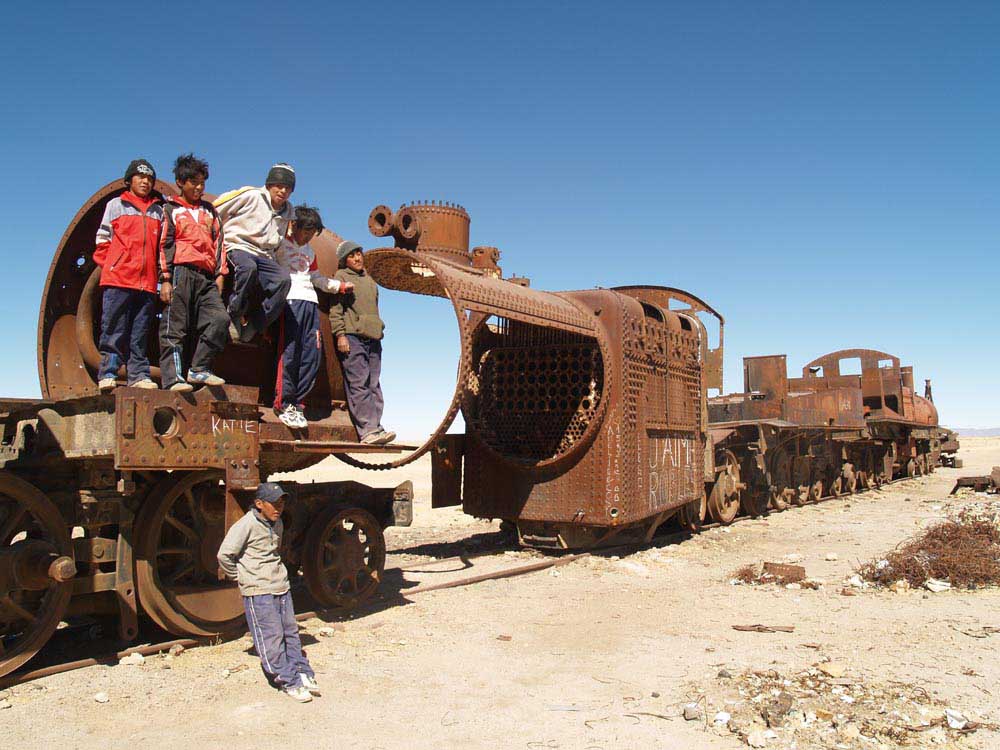
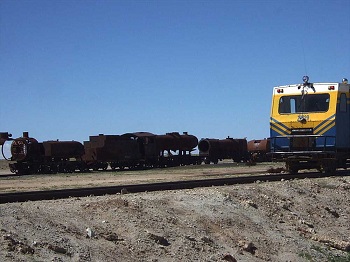
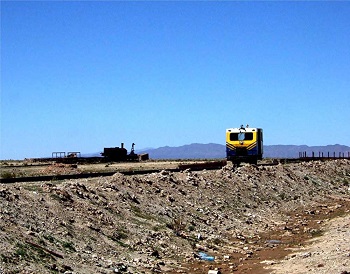
![]()

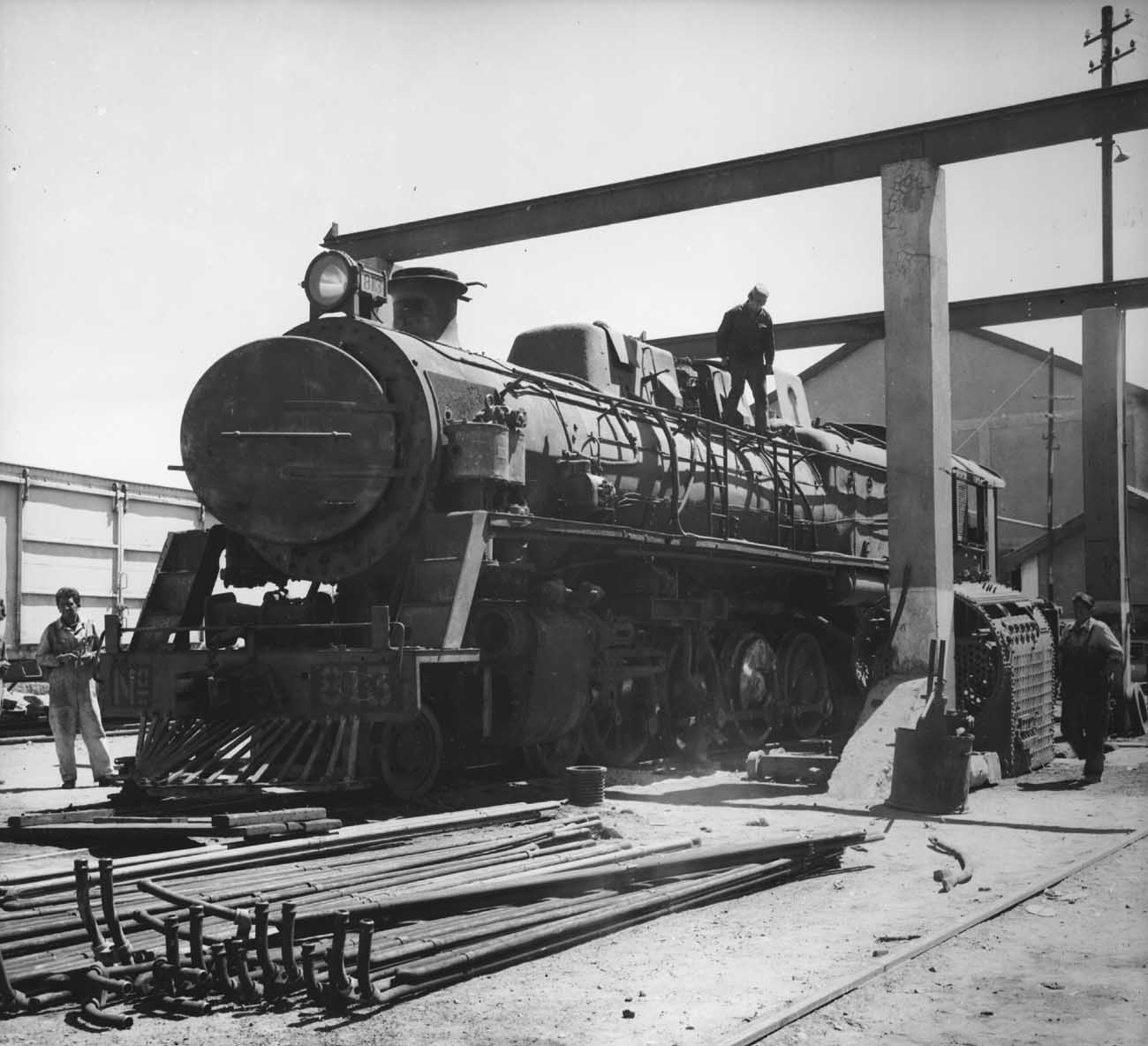
![]()
If Uyuni is perhaps the most visible of the resting places for portions of Bolivia's steam locomotive fleet, one doesn't have to travel too far to find other examples, although one must be cautioned that the accessibility of many of these locomotives is very limited.
Sucre is the home of the El Tejar workshops which are used to house the modern railbuses that work the Sucre - Potosi service. However the vast majority of the locomotives and other rolling stock found in the two workshops have not turned a wheel in many, many years.
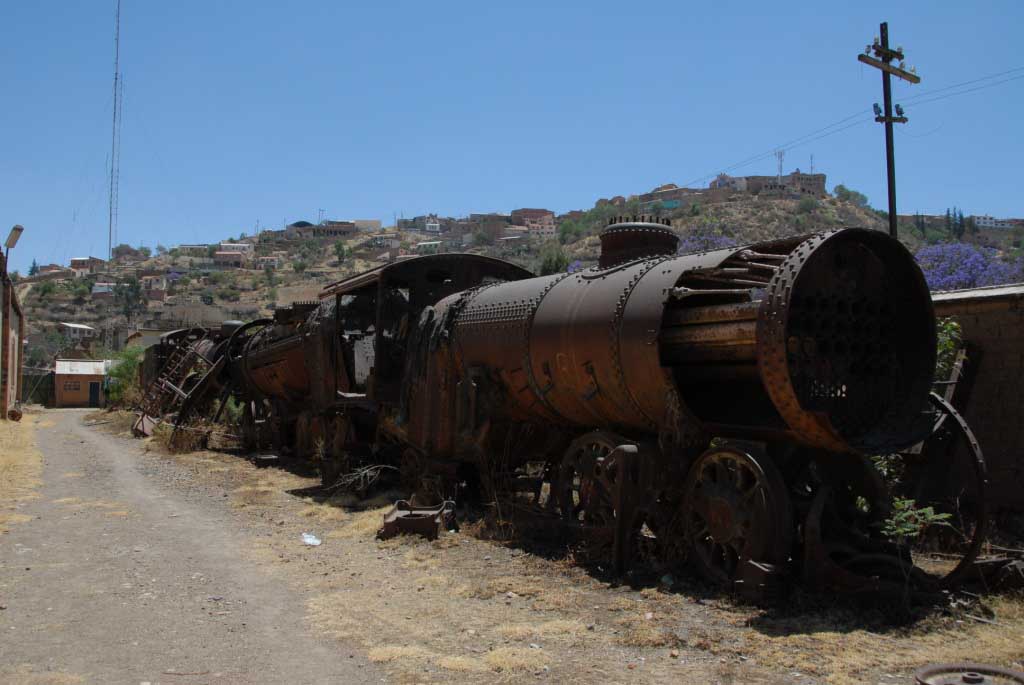
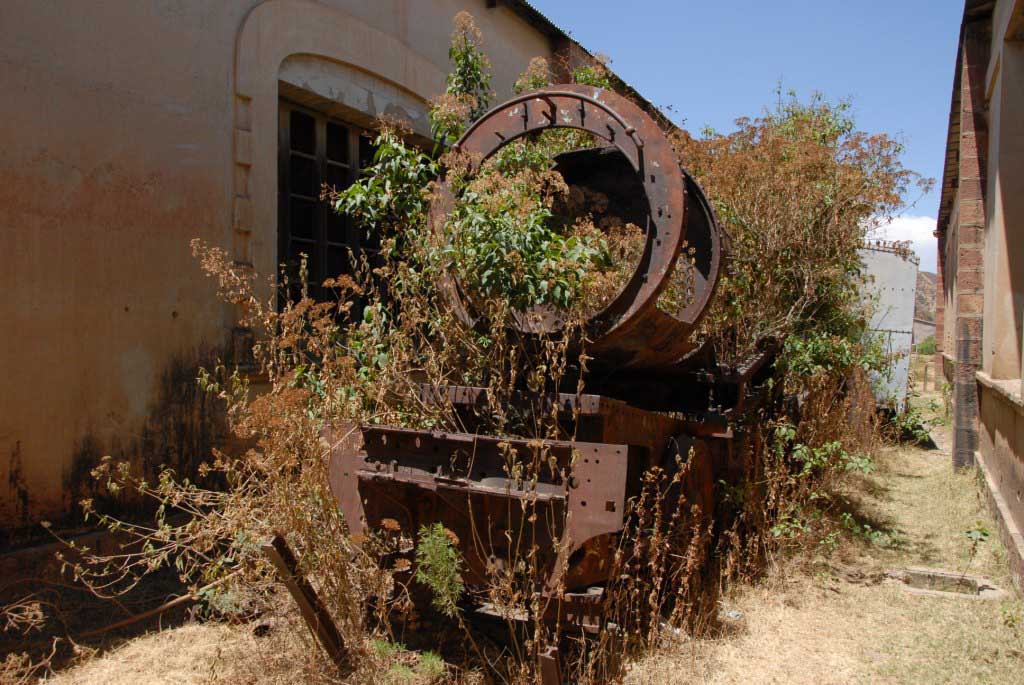

Also present are the remains of the two ex Nordhausen-Wernigerode Mallets. Incredibly it appears that together with Alco 655 at Potosi, the entire known roster of the FC Potosi-Sucre-Tarabuco survives.
Steam Locos:
FCPS 5 (orig 1 (1st)) 2-6-0 VIW 2806 1918
FCPS 6 (orig 2 (1st)) 2-6-0 VIW 2993 1919
FCPS 3 (1st) 0-6-6-0T OK 3939 1910
FCPS 4 (1st) 0-6-6-0T OK 3940 1910
FCPS 2 “ 2-8-2 Alco 64215 1923
FCPS 3 “ 2-8-2 Alco 65937 1924
ENFE 652 2-8-2 OK 11771 1929
FCVA 5 2-8-0 Borsig 12144 1929
ENFE 706 2-10-2 BLW 64621 1943
ENFE 662 2-8-2 Hitachi 2443 1958
ENFE 663 2-8-2 Hitachi 2444 1958
ENFE 669 2-8-2 Hitachi 2452 1958
Additional Details:
FCPS 5, FCPS 3 (1st), FCPS 6, ENFE 669 – Behind workshop in a line, completely overgrown by undergrowth and small trees;
• 669 – Boiler, cab and cylinder block only, frame mostly cut away. Tender on other side of yard. 669 on cabside and smokebox.
• FCPS 6 frame, wheels, boiler, cab and tender lettered “FCPS 6”, tender identical to that on FCPS 6 photo in “ Railways of Bolivia”
• (FCPS 3) (1st) – assumed - dismantled – the two frame units lying next to each other, firebox only remains of boiler, no cylinders but wheels intact, one side tank lying in undergrowth. Carries no identification.
• (FCPS 5) – assumed – boiler (same as FCPS 6) and part of frame plus cylinder block of small US design loco, some wheels lying alongside. Carries no identification.
FCPS 4 (1st) – lying in undergrowth between the main workshop and the railcar workshop, behind a wagon and easily missed. Both frame units, wheels and part of smokebox survive, no cylinders. Some brass parts stamped 4.
FCPS 2 (2nd), FCVA 5, FCPS 3 (2nd) – In a line against the wall separating the works from EL Tejar station yard;
• (FCPS 2) (2nd) – Assumed – one of the 1923 Alco’s - Boiler (part cut), cab and parts of frame plus some wheels survive. No cylinders or tender. No identification on loco.
• (FCVA 5) – Assumed – but definitely a Borsig 2-8-0 - but no identifaction on loco. Boiler (part cut), part of frame and some wheels survive, no cab or cylinders, no tender.
• (FCPS 3) (2nd) – one of the 1923 Alco’s – Boiler (part cut), cab, part of frame, tender (lettered FCPS 3) and some wheels survive. No cylinders.
652 – Inside Workshop, complete. This loco has been rebuilt with its running plate raised by about 18” and the smokebox side valances removed which completely changes its appearance compared with shots in “Railways of Bolivia”. BBP 11771/1929 which means either the boiler was swopped with 651 (at Oruro with BBP 11772/1929) or the accepted ENFE re-numbering from FCCSC 1-2 to ENFE 651-652 is transposed.
663 – Inside Workshop, complete. BBP 12443, rods stamped FCALP 203
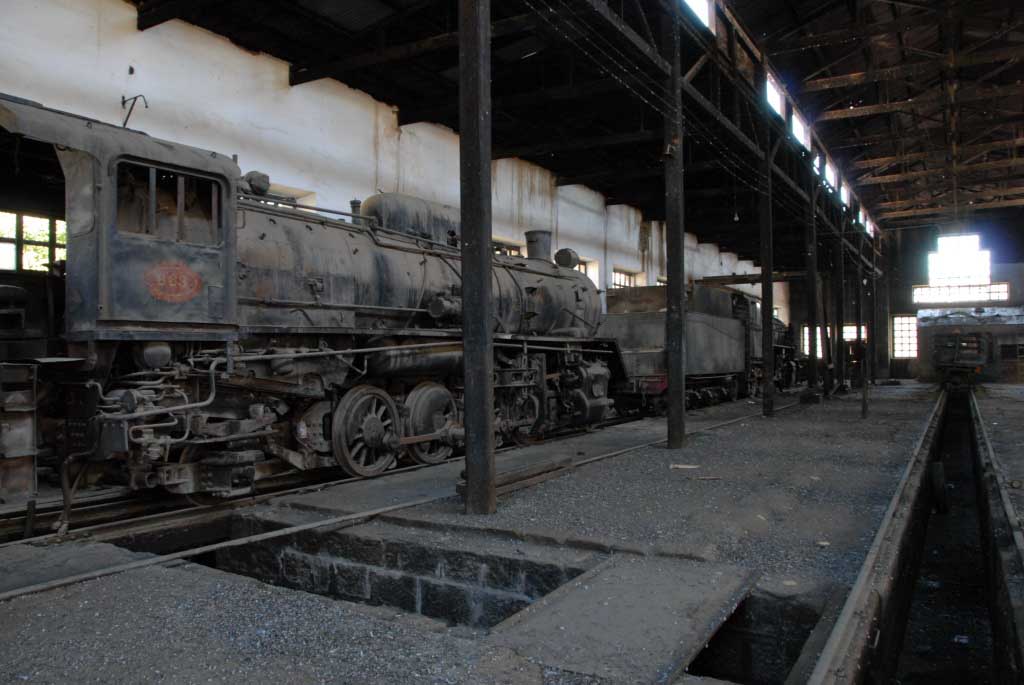
706, 662 – Outside Workshop – complete. 662 has FCALP 202 on rods no BBP; 706 has BBP showing FVCA 12 and Baldwin 64621 of 1943.
Railcars:
The working railcars, and the derelict Dodge rail lorry conversion were found in the main workshop. The remainder were housed in the old railcar workshop. The collection included many of the original FCPS 1930’s railcars built by Wayne, Indiana, photos of which appear in “Railways of Bolivia”. Renumbering from FCPS numbers (which included 11 and 14) to ENFE is unknown. One still carried a Wayne worksplate.
- 4-2wDMR VW ? In use, FCA Blue
202 4-2wDMR VW ? Repairs, Red / Grey
- 4w-2DM Dodge rail lorry Orange - dismantled
215 4-2wPMR Car conversion Green / Yellow
217 4-2wPMR Car conversion Green / Yellow
257 4-2wPMR Wayne 1930s Red / Cream
261 4-2wPMR Wayne 1930s Green / Yellow
262 4-2wPMR Wayne 1930s Green / Yellow
- 4-2wPMR Wayne 1930s Green / Yellow
- 4-2wPMR Wayne 1930s Green / Yellow
- 4-2wPMR Wayne 1930s Green / Yellow
275 Bo-BoPMR Mercedes 1950s? Light Grey-Green
261 4wPMR Inspection Trolley Red
One of the unidentifiable Wayne 1930’s railbuses has severe wreck (rollover) damage, another may be 260 a photo of which appears at Sucre on page 121 of “Railways of Bolivia”. Note there are two “261’s” in the shed. 215 and 217 are conversions of 1930’s US built cars. In the yard was an old road bus body painted yellow (no numbers) which looked as if it may have been undergoing (abandoned) conversion to rail use.
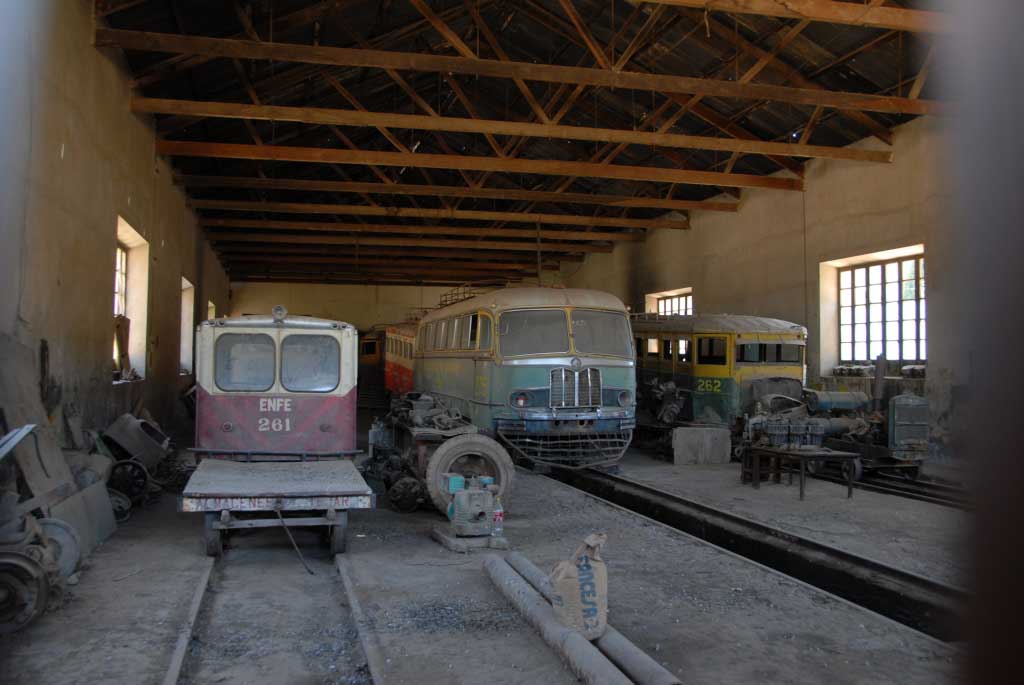
El Tejar information, unless otherwise stated is courtesy of John Middelton.
![]()
Southwest of Sucre lies the city of Potosi, which as mentioned elsewhere is connected to Sucre by a railbus service. The shed at Potosi frequently houses diesel locomotive and inspection vehicles. Three steam locomotives are present outside the two road shed.
The Garratt stands at the front of the shed next to a 1910 water column made in Yorkshire, the other two steam are at the back of the shed. The Garratt carries its FCAB number whilst the other two carry ENFE numbers.
FCAB 397 4-8-2+2-8-4 BP 7424 1950
ENFE 655 2-8-2 Alco 64214 1923
ENFE 666 2-8-2 Hitachi 2447 1958
397 faded cabside number, stamped 397 and 7424 in several places on frame / motion
655 faded cabside number, Alco details per “Railways of Bolivia”
666 faded cabside number, BBP 12447 / 1958, rods FCVA 206 in various places

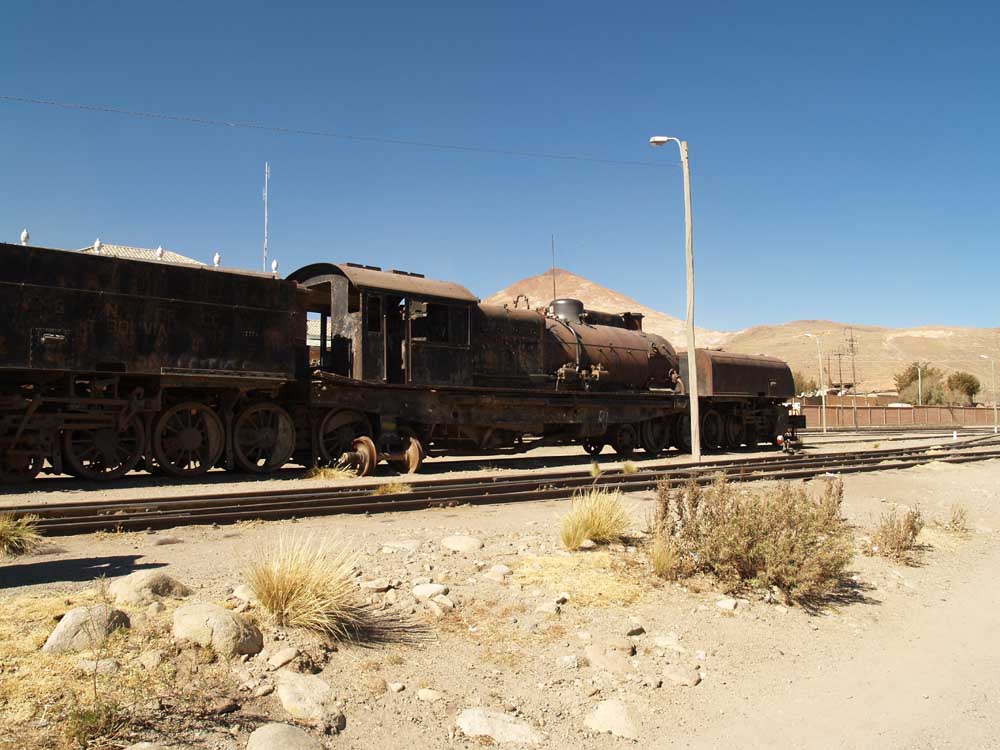
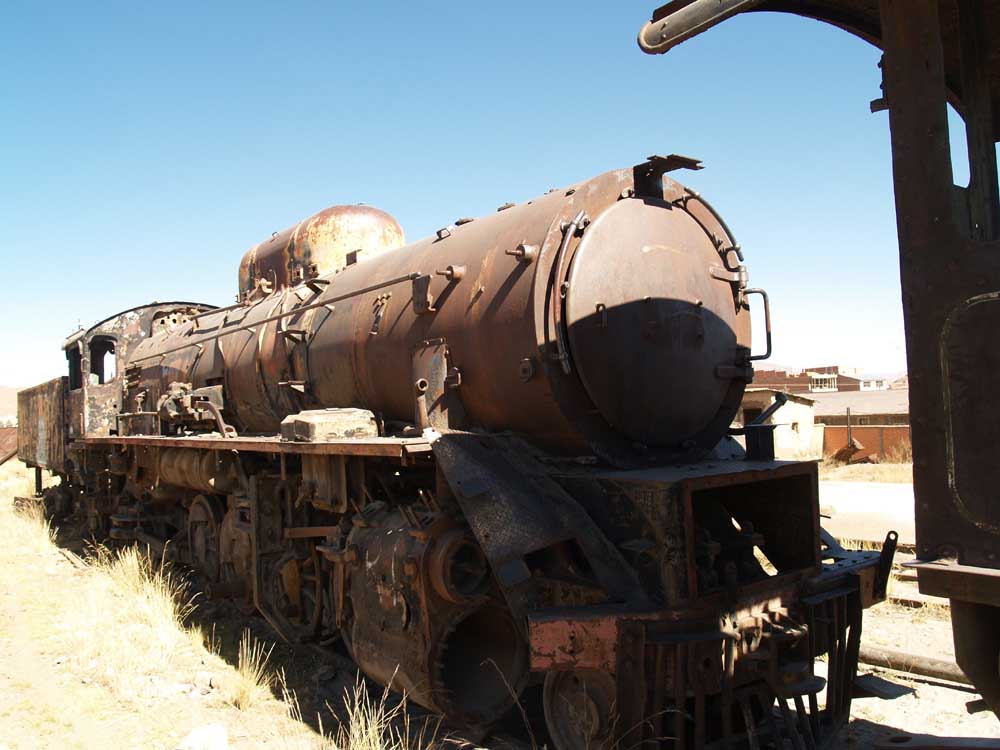
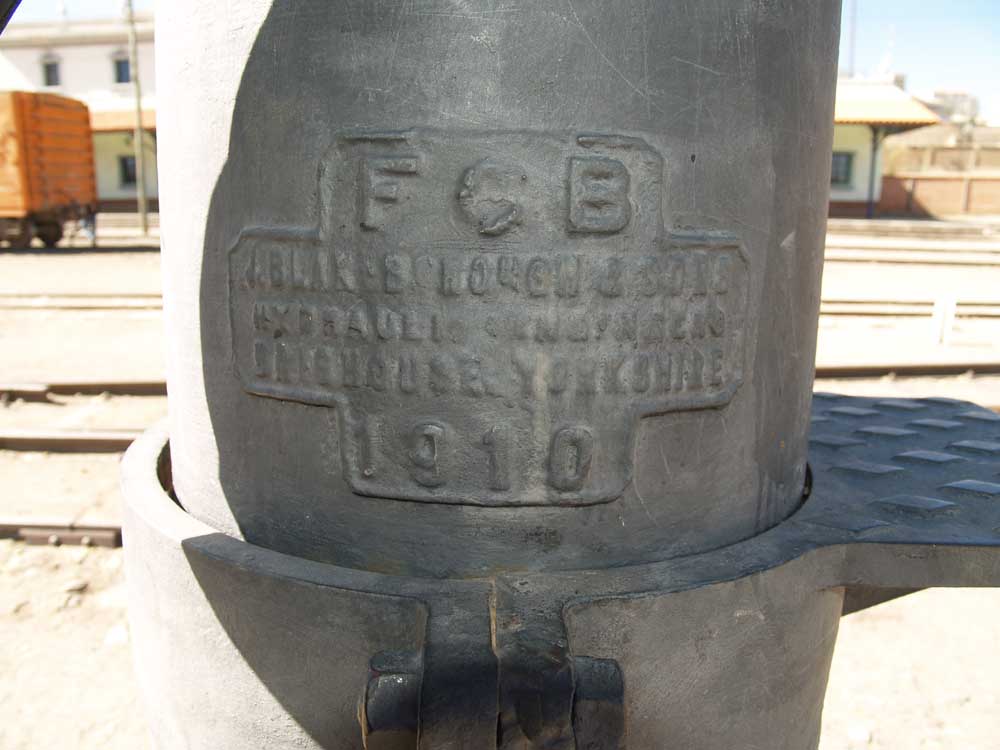
![]()
If the pictures above portray a country which was reached somewhat by the salesman of the Victorian era Industrial Revolution manufacturers it should not be forgotten that three centuries earlier the plundered wealth of Bolivia helped support the Spanish empire and other European nations feeding off the Spanish galleons returning to Spain with their holds loaded with Bolivian silver.
Much of this wealth came from the region of Potosi and in particular the Cerro Rico (silver mountain) which towers over Potosi and can just be seen in one of the photographs above. The silver mines started to play out during the mid 19th Century, but mining continues today with tin now being the primary ore mined, silver, lead, zinc and copper are also extracted in smaller quantities from the mines and the tailings.
The largest mine still worked in the area is the Empresa Minero Metallugica Potosi SA (EMMPSA); Pailaviri Mine. The mine uses a 500 mm gauge overhead electrified line running from a sub-vertical shaft underground out to a tipping point. Ore is now taken away by road to another mill but there is a large derelict mill and a derelict aerial cableway adjacent which were closed over 30 years ago. The mine has 12 levels going down some 700 metres, accessed via the sub-vertical shaft which likely use battery locos.
Gauge: 500 mm
1 4wWE Siemens ? (a) OOU
2 4wWE Goodman (b) Working
3 4wWE Goodman (c) OOU
4 4wWE Schalker (d) Stored
6 4wWE Goodman 7328 (b) Frame Only
7 4wWE Goodman (b) Repairs
9 4wWE Siemens ? (a) OOU
- 4wWE Goodman (b) Working
- 4wWE Goodman (b) Working
- 4wWE Goodman (e) Working
- 4wWE ? (f) Working
- 4wBE Mancha (g) OOU
- 4wBE ? (h) Stored
(a) No identification but with Siemens characteristics, possibly from batch of 6-ton locos SSW 6317-6325 of 1971 delivered to COMIBOL
(b) Low profile Goodmans of about 6 tons
(c) Older Goodman, also of about 6 tons, type 232K motor
(d) Loco appears on mine calenders looking new, but not in use, about 6 ton
(e) Shorter frame Goodman typical of 1/2M75 type (5-ton)
(f) Large loco of about 10 tons, probably European manufacture
(g) dumped upside down in yard, probably 3-4 ton size
(h) small loco of about 2-ton size, unknown manufacture
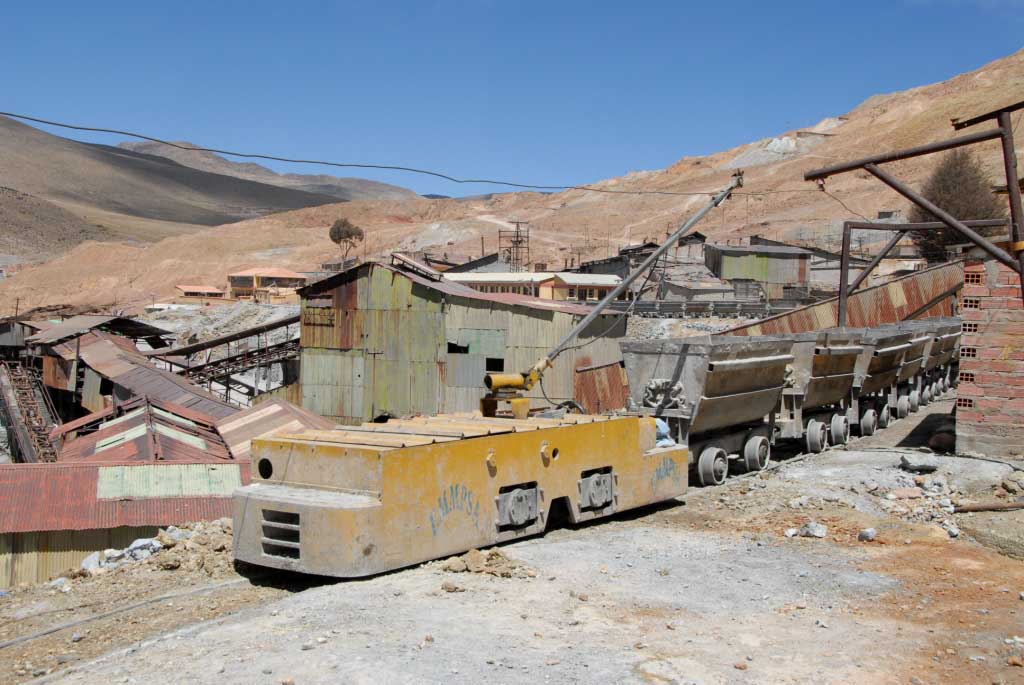
![]()
The Antofagasta & Bolivia Railway
The route of my Bolivian railway journey between Oruro & Uyuni utilised the tracks of the former Antofagasta & Bolivia Railway, which operated between Antofagasta, Chile and Oruro, Bolivia and between Viacha (Bolivia) and La Paz (Bolivia). Through service between Oruro & Viacha utilised a leasing agreement with the Bolivia Railway Company.
The line between Antofagasta and Oruro was completed in stages between 1873 and 1892, the Huanchaca Mining Company being the original owners. In 1888 they sold the line to new owners but continued to work the line until 1904.
By 1926 the mileage operated by the Antofagasta & Bolivia Railway was 1,671 miles, comprised of the following:
Lines Owned:
Antofagasta & Mejillones - Oruro (main line and branches): 794 miles
Viacha - La Paz: 19 miles
Lines Leased from the Bolivia Railway Company:
Branch from Uyuni to Atocha: 56 miles
Branch from Rio Mulato to Potosi: 108 miles
Branch from San Pedro to Cochabamba: 127 miles
Main Line from Oruro to Viacha: 126 miles
From July 1919 the Antofagasta & Bolivia Railway also operated the 441 miles of the Chilean Northern Longitudinal Railway between Pueblo Hundido, Baquedano and Pintados.
When built the gauge between Antofagasta and Uyuni was 2ft 6in, from Uyuni it was metre gauge. Generally the main line featured a minimum grade on the line of 3%, with mimimum curves of 120m radius, with the exception of the descent into La Paz which featured curves up to 15 degrees. Generally the main line was laid with 75lb & 65lb rails on wooden sleepers, but in the 1920s on the Bolivia sections steel sleepers were to replace wooden sleepers. On the branches 50lb, 60lb & 65lb rail was used, some of the Bolivian branches utilising steel sleepers.
Prinicipal elevations:
Antofagasta: sea level
Portezuelo: 554m (29km from Antofagasta and where the double track ends)
Baquedano: 1,030m (mixed gauge terminates here)
Ascotan: 3,955m (highest station on the main line)
Ollague: 3,696m (Chile / Bolivian border, 444km from Antofagasta)
Rio Mulato: 3,816m (721km from Antofagasta)
Oruro: 3,696m (929km from Antofagasta)
Calamarca: 3,954m (1,092km from Antofagasta)
Viacha: 3,858m (1,130km from Antofagasta)
Kenko: 3,981m (1,146km from Antofagasta)
La Paz: 3,690m (1,161km from Antofagasta)
The above information is taken from a 1926 Railway Gazette article, some of the station elevations have since been changed.
![]()
Resources:
With thanks to John Middleton for much of the tabular information and many of the views at El Tejar & Potosi.
Page added October 2002.
Last updated January 10th 2020.
Return to the 2002 visit to Bolivia page
Return to the Machacamarca - Uncia Sulzer page
Return to Picture menu